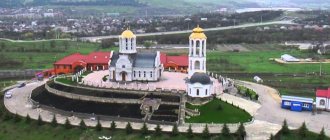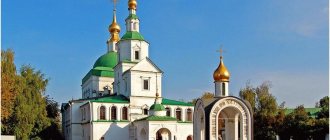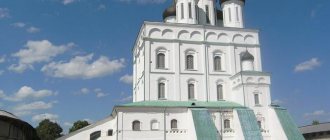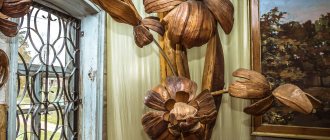The St. George Monastery has stood on the rocks of Cape Fiolent for more than a thousand years, as if protecting the peace of this place. Neither the Genoese nor the Turks, who came to Crimea as new owners in the Middle Ages, touched the shrine. Only after the revolution the monastery ceased its activities.
Photo of the monastery:
History of the shrine
Nobody knows when this unique Orthodox building first appeared on Fiolent.
The Chronicles of Genoa say that in the 14th century the monastery already stood on the cape, which became the outskirts of the consulate of Cembalo (today's Balaclava). In 1475, the Turks did not destroy it - the temple complex was under the jurisdiction of the Patriarchate of Constantinople. 1794 was the time when the men's monastery came under the care of the Holy Synod of the Russian Orthodox Church. Already under the Russians, the local elder Kalinnik continued his asceticism.
By that time, Sevastopol began to expand. St. George's Monastery was revered by the entire population of the large city located next door. It was then called Balaklava - the Crimean capital at the end of the 18th century did not go so far to the east, and Balaklava, hidden in a neighboring bay, was only 4 km away. By the time of the Crimean War, the monastery had grown several times. Even after this and the Great Patriotic War, something remained of it. This refers to the two-story cave buildings of the Church of the Nativity.
Information for visiting - tips on how to get there
Anyone can attend a service at the St. George Fiolentovsky Balaklava Monastery. They take place every day at 8.30. Holiday and Sunday services are also held. In addition, those who wish can stay here as laborers or novices.
The monastery has its own page on the social network. You can find out the information you are interested in at: https://vk.com/georgiosmonastery
You can get to the monastery by bus from Sevastopol or Balaklava. Their final point is “Fiolent”.
Also, boats run from Balaklava to Jasper Beach during the tourist season.
St. George's on the map of Crimea
GPS Coordinates: 44.505864, 33.510473 Latitude/Longitude
Legends about the temple on Fiolent
One of the old legends tells about an event in 890 -
when Chersonesus was part of Byzantium. On Fiolent, local fishermen became victims of a shipwreck in bad weather. Then the cape was called Parthenium (“place of the Virgin”). Having lost all hope, the fishermen appealed to the Great Martyr St. George the Victorious. He heard them and saved them, giving them a gift in memory of what happened. The next day, the townspeople carved a small temple into the rock and placed the icon given to them there.
Some of the rescued began to live in a cave - people became ascetics. The myth says - thus, the forerunner of the current men's monastery was born. By the way, the celestial being appeared on the reef - the place was called the Rock of the Apparition of the Saint. It is still visible both from water and from land. Many centuries later, Russian ascetics settled in the rock church. In an incomprehensible way, the Victorious filled not only them, but also the Russian sailors with courage and determination. After visiting the monastery, people heard the voice of the saint.
About archaeological excavations and more
After the publication of this article, Dmitry Nikolaevich Anfinogenov, and added many interesting details to the material. With his permission, I present excerpts from our correspondence.
In 1911, the funeral service for Ilya Sats was held in the St. George Church. Natalia Sats's letters talk about newsreels of her father's funeral. We have not yet been able to find this film.
There are no passages under the sports ground. Archaeologists dug everything up there. The photo shows part of the basements that were located in the passage between the school and the bank (former cells). The bank employees did not let me into the basements of the building (17th century), but told me about the closed passage. Under the hill behind the school, behind the Kamergersky houses, there are also basements. All this was revealed by workers several years ago. They gave the school 2 kopecks in silver.
There used to be a stream in the basement. The magic door (the one that worried us so much in the basements of the locker room - M.A.) is a warehouse for sports equipment. The only rarity found there is part of the foundation made of white stone, but this is from the exit side opposite the dining room. If you look at the location of the storage room for inventory, this is the southern side of the refectory; there were the crypts of Zotov and Romodanovsky.
Andrei Zhiltsov (former student of the school - M.A.) said that when archaeologists found something, classes at the school were canceled. I think the boys were more interested in the events around the school. Mathematics teacher Liliya Sergeevna recalled how Lisenkov rolled skulls stolen from burials around the classroom. Mikhail Yurievich and Hovhannes Georgievich (teachers) saved the crypts discovered by archaeologists from looting by schoolchildren. The history teacher collected materials about the excavations and the history of the place, but when he left the school, all the documents disappeared. I started working in 1992 and knew nothing about these events until I accidentally saw the engraving “Church in Georgievsky Lane.” Since 1999, I began collecting materials myself.
Do you know archaeologist A.G. Veksler? I met him on the advice of Valentina Dmitrievna Nikitina (school director until 2001). Alexander Grigorievich met me in his office and told me that the excavations were an emergency, i.e. a large construction project was planned. He was outraged by the hype surrounding the supposedly found large golden cross, which was not there. He carefully took Hirshberg's work from the shelf and recommended studying it. He also said that all the found remains were reburied in the St. Danilovsky Monastery. He promised to help the school museum with exhibits...
I will tell you an incident from the life of a school sports ground. Spring 2010?. Spring waters opened an opening in the ground. In the depths is a white stone tombstone.
What attracts tourists to the St. George's Monastery?
The above-ground St. George's Monastery on Fiolent in its current appearance appeared to the eyes of Crimeans only in 2008. The building is a genuine reconstruction of a structure erected in 9-14. century before last (demolished under Soviet rule). It was built according to all the canons of Russian classicism. The interior decoration was decorated with lithographs by some of the best European artists. Now the interior is, of course, different. However, two fraternal complexes, the St. George Fountain, a bell tower, an elongated refectory, a rotunda gazebo and a chapel have been restored.
Now the majority of the described complex is located on the base of one of the military units of the Russian Black Sea Fleet.
At this point it is appropriate to mention that St. George is traditionally considered in Russia to be the “source” of victory. Sevastopol was in a state of siege several times - the sailors and soldiers stationed in the city needed Victoria constantly. Since 1813, the monastery even received the “rank” of a naval monastery - the monks who had lived here for 7 years began to serve as chaplains on warships. Many of them fought themselves, becoming famous heroes and examples for modern cadets.
Within this place of sacraments are the ruins of the archive and the monastery cemetery, where such famous monks as Chrysanthos of Novopatras and Agathangelus Tipaldo (both of whom were abbots of the monastery at the end of the 18th century) are buried. The objects once built by Russian monks include the site in front of the source of St. George, as well as the staircase starting from here, which at the end of the 19th century had 891 steps. Even now it is the longest man-made descent on the peninsula. As you approach Jasper Beach, you will be greeted by the ruins of the tiny mansion of Admiral Lazarev.
Don't miss: Review of the new park near the St. George's Monastery
The church at this landmark of Sevastopol is considered active and gives spiritual bliss to a huge number of parishioners and guests. The schedule of services can be found just outside the gate. Entry in beachwear is prohibited. Women should appear at the porch and porch with their heads already covered.
Pilgrim[edit]
Where to stay[edit]
The pilgrimage hotel is designed for 30 people, it has cozy rooms for two, three or four people. The room has all the necessary furniture - a wardrobe, bedside table, chairs and beds.
On the floor there are combined bathrooms with plumbing fixtures. The spacious refectory on the ground floor of the hotel offers guests a comprehensive meal plan made from organic products.
While on the territory of the courtyard, guests can enjoy the local beauty - the hotel windows offer stunning views of the sea and mountains.
Schedule of services[edit]
See the current schedule of services on the monastery website
.
Architect, exterior decoration, architectural ensemble
St. George Monastery in Sevastopol, Cape Fiolent, belongs to an unknown architect. The first buildings of the monastery were built from wild stone, and have remained unchanged to this day, having undergone minor later restorations. The monastery includes a large number of buildings from different years of construction.
On the central plateau there is a bell tower, a library building, chapels and several monuments. On the terrace there are churches of St. George and the Church of the Nativity of Christ, fraternal buildings, the refectory building, chapels and a source.
In the vicinity of the monastery there are also stairs to Jasper Beach, the monastery necropolis and St. George's Rock in the sea. All this makes up the overall architectural ensemble. Externally, the monastery does not have any special architectural frills: it is quite austere and built in the style of classicism.
This is interesting: Cathedral of St. Nicholas the Wonderworker in Evpatoria: photo of the temple, how to get there, description
After the revolution
After the revolution, the relationship between the St. George Church and the Bolshoi Theater led to tragedy. In May 1930, the theater administration demanded that the long-closed church be demolished to build workshops in its place. Restorers proposed preserving the temple by rebuilding it into the required workshops. However, the request of the theater management was supported by the People's Commissariat for Education. They decided to take advantage of this and at the same time demolish the Kazan Church. While the preparatory work was underway, the building of the St. George Church was transferred to the capital's taxi company for use, which completely disfigured its appearance. Both temples were demolished. A typical Soviet school [2] was built on the site of St. George’s Church as a symbol of “socialist enlightenment instead of church obscurantism.” The temple icon of St. George was transferred to the Church of the Resurrection of the Word on the Assumption Vrazhek near Tverskaya, and the tombstone was transferred to the Museum of the Spaso-Andronikov Monastery. And only the name of Georgievsky Lane remains from the glorious Moscow monastery.
Interior decoration
Inside, the main temple of the monastery is a magnificent example of temple architecture. The main cathedral is completely painted: inside the central dome, Christ, angels and saints are depicted.
The temple is decorated with icons of canonical painting, the main color is blue, symbolizing the sky and heavenly Jerusalem, the temple is completely covered with paintings and geometric patterns. Inside the temple there is a three-tier iconostasis made of dark wood. The temple can accommodate about 500 people inside.
Patronal holidays[edit]
Nativity
- Jan. 7
Exaltation of the Life-Giving Cross of the Lord
- September 27
Icon of the Most Holy Theotokos “Iverskaya”
— October 26, February 25, May 6
Andrew the First-Called, Apostle
- December 13th
St. George the Victorious, Great Martyr
- the 6th of May
Cathedral of Crimean Saints
- December 28th










